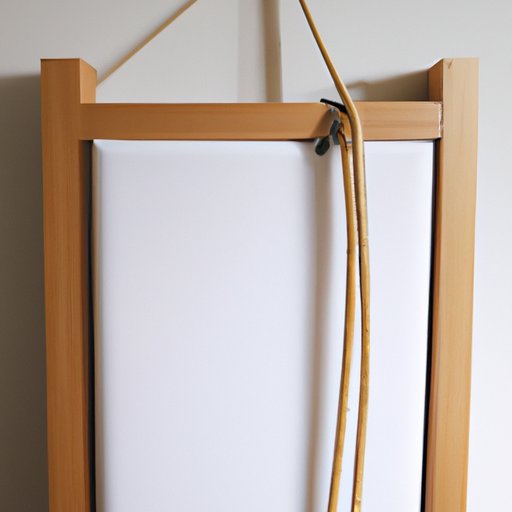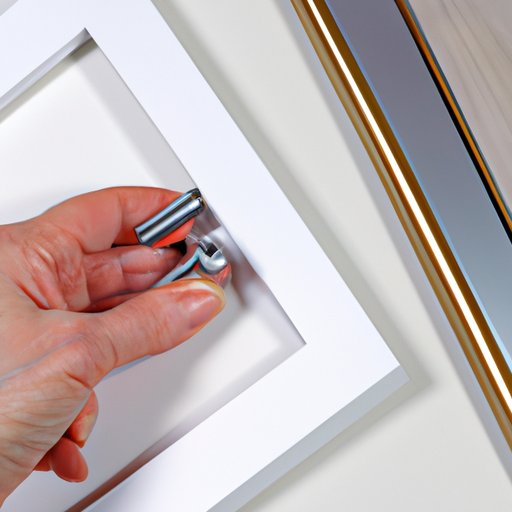
Introduction
Framing a canvas can add elegance and value to any piece of artwork. A properly framed canvas will protect it from elements like dust and moisture, while also giving the artwork a polished and complete look. Whether you’re a professional artist or looking to display a beloved family photo, framing a canvas is a simple and rewarding project that can be done at home with minimal tools and materials.
This article will take you through all the steps needed to frame a canvas, including choosing the right frame and hardware, and avoiding common mistakes. We’ll also cover a variety of creative ways to showcase your artwork without a traditional frame. By the end of this guide, you’ll feel confident framing your own canvas art like a pro.
Step-by-Step Guide to Framing a Canvas
Before we dive into the different types of frames and DIY options, let’s go through the basic steps of how to frame a canvas:
Materials Needed to Frame a Canvas
– Framing kit (frame, cardboard or foam board, hardware)
– Utility knife or saw
– Measuring tape
– Pencil
– Sandpaper
– Glue or double-sided tape
Preparing the Canvas for Framing
1. Remove any staples, nails, or other fasteners from the canvas using pliers or a staple remover.
2. Clean the canvas with a soft cloth, removing any dirt or dust.
3. Allow the canvas to air-dry if it’s been recently cleaned with water or solvent.
Measuring and Cutting the Frame to Size
1. Measure the width and height of the canvas.
2. Add at least 1/8 inch to each side to account for overlap between the frame and the canvas.
3. Use a saw or utility knife to cut the frame to the appropriate size.
Assembling the Frame and Attaching It to the Canvas
1. Assemble the frame according to the instructions provided with the framing kit.
2. Place the cardboard or foam board behind the canvas and center the canvas over the board.
3. Apply glue or double-sided tape to the edges of the board and press it down onto the canvas.
4. Flip the canvas over so the front is facing down.
5. Place the frame over the canvas and attach the hardware according to the instructions.
Securing the Canvas in Place
1. Ensure that the canvas is centered inside the frame.
2. Gently push the canvas into the frame so it sits snugly against the front of the frame.
3. Use tabs or staples to secure the canvas to the back of the frame.
Finishing Touches
1. Sand down any rough or uneven edges on the frame.
2. Wipe the frame with a soft cloth to remove any debris.
3. Apply any desired finish to the frame, such as varnish or paint.
Types of Frames That Compliment Canvas Art
Choosing the right frame for your canvas art is crucial to getting the look and feel you desire. Here are some popular options to consider:
Traditional Wooden Frames
Wooden frames are classic, and come in a variety of finishes and profiles that complement almost any artwork. They are perfect for traditional or vintage-themed artwork.
Contemporary Metal Frames
Metal frames are sleek and modern. They are a great choice for abstract, geometric, or contemporary artwork.
Ornate Frames
Ornate frames are highly decorative and often feature intricate carvings and details. They are best used for formal or elegant artwork.
Floater Frames
Floater frames are unique in that they do not cover the edges of the canvas like traditional frames. Instead, they create a “floating” effect that showcases the edges of the canvas. They are great for abstract, modern, or minimalist artwork.
Shadow Box Frames
Shadow box frames create depth and dimension by elevating the canvas off of the backing board. They are perfect for three-dimensional artwork or objects, such as sculptures.
Important Considerations When Choosing a Canvas Frame
There are several things to keep in mind when selecting a frame for your canvas art:
Size and Proportion
The frame should be proportional to the size of the canvas, with enough overlap to secure the canvas in place. For example, a large canvas may require a thicker frame or a shadow box frame to prevent it from appearing too heavy or overpowering.
Color and Finish
The color and finish of the frame should complement the colors and tones of the artwork. A dark frame may overwhelm lighter artwork, while a white frame may make dark artwork appear washed out.
Style and Theme of the Artwork
The frame should enhance the style and theme of the artwork without overpowering it. For example, a vintage artwork may benefit from a carved wooden frame, while a modern piece may require a simple metal frame.
Quality of the Frame
Investing in a high-quality frame will ensure that your artwork is well-protected and displayed elegantly. Cheap frames may warp or discolor, harming the artwork over time.
Budget Considerations
Finally, consider your budget when choosing a frame. While expensive frames may be high quality, you don’t need to break the bank to create a beautiful display for your canvas art.
DIY Canvas Frame: Tips to Create a Custom Frame
If you’re feeling crafty, you can create your own custom frame for your canvas art. Here’s how:
Tools and Materials Needed
– Lumber (at least 1 inch thick)
– Saw
– Measuring tape
– Sandpaper
– Glue or wood screws
– Stain or paint for finishing
Step-by-Step Instructions for Creating a Custom Frame
1. Measure the dimensions of your canvas and determine how thick you want the frame to be.
2. Cut four pieces of lumber to the appropriate length, adding 1/4 inch to each piece to account for overlap.
3. Sand down the edges of the lumber to create a smooth surface.
4. Apply glue or use wood screws to attach the four pieces together to create a rectangular frame.
5. Attach the canvas to the frame using staples or tabs.
6. Finish the frame with a coat of stain or paint.
Ideas for Personalizing the Frame
– Use stencils or decals to create patterns or letters on the frame
– Add decorative knobs or hinges to the corners of the frame
– Use multiple frames of different sizes to create a gallery wall
Creative Ways to Showcase Canvas Art Without a Traditional Frame
If you’re looking for a more unique way to display your canvas art, consider these creative alternatives:
Using Floating Shelves or Picture Ledges
Instead of using a traditional frame, place your canvas art on a floating shelf or picture ledge. This creates a clean and modern look that showcases the artwork in a unique way.
Displaying the Canvas on an Easel
Use a decorative easel to showcase your canvas art as a standalone art piece. This is a great option for larger canvases that may be difficult to hang on a wall.
Hanging the Canvas from a Rope or Wire
Attach a rope or wire to the back of the canvas and hang it from a decorative hook or knob. This creates a rustic or bohemian look that’s perfect for earthy or nature-themed artwork.
Using Decorative Washi Tape or Clips to Hang the Canvas
For a fun and playful look, use decorative washi tape or clips to hang your canvas art. This is a great option for children’s artwork or for adding pops of color and pattern to your walls.
Common Mistakes to Avoid When Framing Canvas Art
Here are some common mistakes to avoid when framing canvas art:
Choosing a Frame That Is Too Small or Too Large
The frame should be proportional to the size of the canvas. A frame that’s too small will make the artwork look crowded, while a frame that’s too large can overpower the artwork.
Selecting a Frame That Clashes with the Artwork
The frame should complement the colors and tones of the artwork, not clash with it. Avoid frames that are too busy or bright, as these can detract from the artwork.
Using Low-Quality Materials or Construction Methods
Using cheap frames or materials can damage the artwork over time. Ensure that you’re using high-quality frames and hardware to properly protect your canvas art.
Failing to Properly Secure the Canvas in the Frame
A loose canvas in a frame can cause damage over time. Ensure that your canvas is properly attached to the frame using tabs or staples.
Ignoring the Importance of Dusting and Cleaning the Frame
Dust and debris can accumulate on the frame over time, leading to discoloration or damage. Regularly dust and clean your framed canvas art to maintain its beauty and integrity.

How to Choose the Right Hardware to Hang a Framed Canvas
Choosing the right hardware for hanging your framed canvas is essential to ensure that it stays securely on the wall. Here’s what you need to know:
Choosing the Right Picture Hanger or Hook
Depending on the weight of your canvas, you’ll need to choose a picture hanger or hook that can support it. A common option is a sawtooth hanger, which can hold up to 20 pounds.
Determining the Weight of the Canvas and the Appropriate Hardware
To determine the weight of your canvas, weigh it on a digital scale. Then, choose hardware that can support that weight. If in doubt, choose hardware that can hold more weight than your canvas actually weighs to be safe.
Tips for Centering the Canvas on the Wall
To center your canvas on the wall, measure the width of the canvas and divide it by two. Then, measure that distance from the center of the wall and mark it with a pencil. This is where you’ll hang the picture hanger or hook.
Measuring and Marking the Wall for Optimal Placement
When hanging multiple canvases on a wall, measure and mark the wall to ensure that they are spaced evenly and aligned properly. Use a level to ensure that each canvas is hung straight.
Conclusion
Framing a canvas art is a simple and rewarding project that can add beauty and value to any space. By following the steps provided in this guide, you’ll confidently choose the right frame and hardware for your canvas art, whether you opt for a traditional frame or a more creative display. Remember to avoid common mistakes such as choosing the wrong size frame or using low-quality materials, and clean and maintain your framed canvas art regularly to keep it looking its best.




